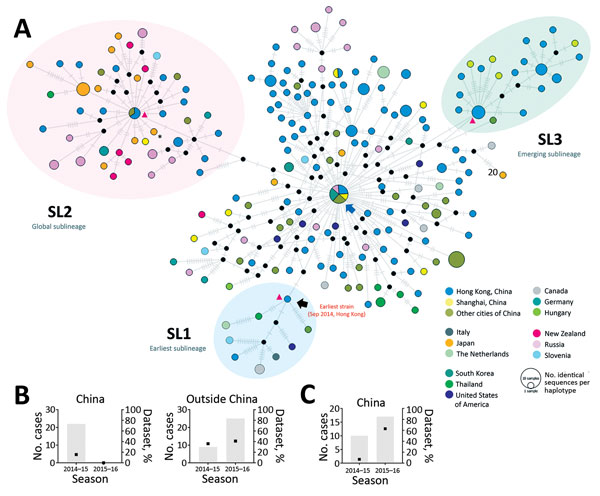Global Spread of Norovirus GII.17 Kawasaki 308, 2014–2016
Martin C.W. Chan, Yunwen Hu, Haili Chen, Alexander T. Podkolzin, Ekaterina V. Zaytseva, Jun Komano, Naomi Sakon, Yong Poovorawan, Sompong Vongpunsawad, Thanundorn Thanusuwannasak, Joanne Hewitt, Dawn Croucher, Nikail Collins, Jan Vinjé, Xiaoli L. Pang, Bonita E. Lee, Miranda de Graaf, Janko van Beek, Harry Vennema, Marion P.G. Koopmans, Sandra Niendorf, Mateja Poljsak-Prijatelj, Andrej Steyer, Peter A. White, Jennifer H. Lun, Janet Mans, Tin-Nok Hung, Kirsty Kwok, Kelton Cheung, Nelson Lee, and Paul K.S. Chan

Author affiliations: The Chinese University of Hong Kong, Hong Kong, China (M.C.W. Chan, T.-N. Hung, K. Kwok, K. Cheung, N. Lee, P.K.S. Chan); Fudan University, Shanghai, China (Y. Hu, H. Chen); Central Research Institute of Epidemiology, Moscow, Russia (A.T. Podkolzin, E.V. Zaytseva); Nagoya Medical Center, Nagoya, Japan (J. Komano); Osaka Prefectural Institute of Public Health, Osaka, Japan (N. Sakon); Chulalongkorn University, Bangkok, Thailand (Y. Poovorawan, S. Vongpunsawad, T. Thanusuwannasak); The Institute of Environmental Science and Research, Porirua, New Zealand (J. Hewitt, D. Croucher); Centers for Disease Control and Prevention, Atlanta, Georgia, USA (N. Collins, J. Vinjé); University of Alberta, Edmonton, Alberta, Canada (X.L. Pang, B.E. Lee); Alberta Provincial Laboratory for Public Health, Edmonton, Canada (X.L. Pang); Erasmus MC, Rotterdam, the Netherlands (M. de Graaf, J. van Beek, M.P.G. Koopmans); National Institute for Public Health and the Environment, Bilthoven, the Netherlands (J. van Beek, H. Vennema, M.P.G. Koopmans); Robert Koch-Institute, Berlin, Germany (S. Niendorf); University of Ljubljana, Ljubljana, Slovenia (M. Poljsak-Prijatelj, A. Steyer); University of New South Wales, Sydney, New South Wales, Australia (P.A. White, J.H. Lun); University of Pretoria, Pretoria, South Africa (J. Mans)
Main Article
Figure 2

Figure 2. Median-joining haplotype network of 254 complete viral protein 1 nucleotide sequences of norovirus GII.17 Kawasaki. Each vertex represents a unique sampled haplotype. Internal black nodes are unsampled intermediate hypothetical haplotypes. A) Black arrow denotes the first case of norovirus GII.17 Kawasaki in this study (NS-405; collected in September 2014 from Hong Kong). Blue arrow denotes a highly connected basal haplotype from which nearly all haplotypes originated. Vertices are colored by country of collection. Blue shading indicates a sublineage (SL1) genetically closest to the first case of GII.17 Kawasaki virus in this study. Pink shading indicates a sublineage (SL2) with global spread. Green shading indicates an emergent sublineage (SL3) in China in 2016. Vertex size is proportional to the number of sampled sequences sharing the same haplotype. Length of edge is not drawn to scale. Each hatch mark indicates 1 nt difference between connecting haplotypes/nodes. Red triangles represent reference strains of corresponding sublineage (Technical Appendix Table 1). The asterisk denotes the reference sequence of GII.17 Kawasaki virus (Hu/GII/JP/2015/GII.P17_GII.17/Kawasaki308; GenBank accession no. LC037415). Bar charts show the number (gray bars) and percentage (black squares) of cases of sublineages SL2 and SL3 by country in the seasons of 2014–15 (September 2014–June 2015) and 2015–16 (July 2015–March 2016).
Main Article
Page created: July 17, 2017
Page updated: July 17, 2017
Page reviewed: July 17, 2017
The conclusions, findings, and opinions expressed by authors contributing to this journal do not necessarily reflect the official position of the U.S. Department of Health and Human Services, the Public Health Service, the Centers for Disease Control and Prevention, or the authors' affiliated institutions. Use of trade names is for identification only and does not imply endorsement by any of the groups named above.
